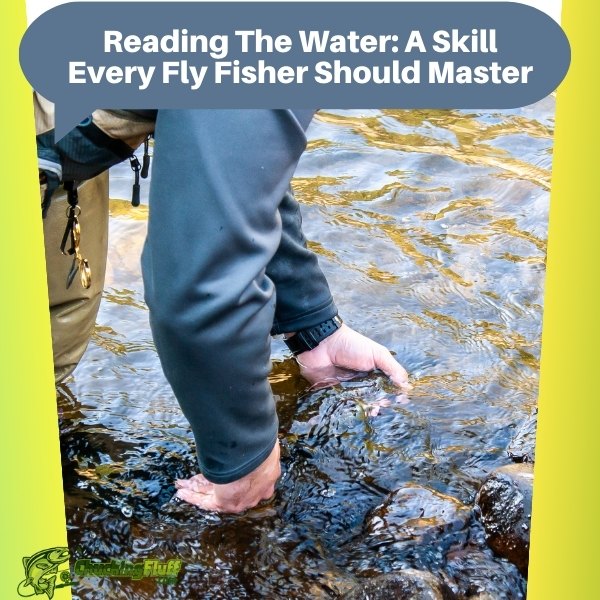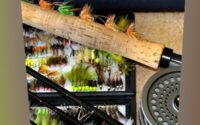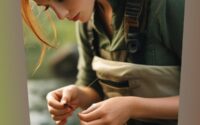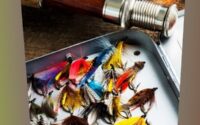| Disclosure: Just to be open and honest the buttons and links you click on in the website will in most cases take you to another website where you can purchase the products I am reviewing. As an Amazon Associate I earn from qualifying purchases. |
Reading The Water: A Skill Every Fly Fisher Should Master
Quick Post Navigation
- Introduction:
- Understanding the Components of Water:
- Identifying Prime Fishing Spots:
- Techniques for Reading Water:
- Equipment and Gear for Effective Reading:
- Practical Tips for Beginners:
- Advanced Strategies for Experienced Anglers:
- Safety Precautions and Environmental Awareness:
- The Art of “Reading” Fish Behavior:
- The Psychological Aspect of Reading Water:
- Common Mistakes to Avoid:
- The Evolution of Reading Water Techniques:
- Overcoming Challenges in Reading Water:
- The Future of Reading Water in Fly Fishing:
- Conclusion:
- Unique FAQs:
- “Check out some of our other Buying Guides”

Introduction:
Fly fishing, often regarded as a harmonious blend of art and science, invites anglers into a world where the delicate dance between angler and fish unfolds amidst the rhythmic flow of water. Central to this captivating pursuit is the age-old skill of reading the water – an intricate process that transcends mere observation, delving into the very essence of a river or stream. Like a seasoned detective deciphering clues, fly fishers learn to decode the subtle nuances of currents, depths, and structures, unveiling the hidden secrets that lie beneath the surface.
In the realm of fly fishing, the ability to read water is not merely a skill; it is a sacred art form passed down through generations. It is the keen eye that discerns the faintest ripples, the patient heart that waits for the telltale rise, and the intuitive mind that anticipates the unseen currents. From the babbling brooks of remote mountain streams to the meandering rivers of sprawling valleys, each body of water tells its own unique story – a story waiting to be deciphered by those who possess the wisdom to listen.
In this article, we embark on a journey into the heart of fly fishing, exploring the depths of water reading and uncovering the secrets that lie beneath the surface. Through careful observation, thoughtful interpretation, and a deep reverence for the natural world, we seek to unravel the mysteries of the water and unlock the key to angling success.
Understanding the Components of Water:
Water is not uniform; it has various components that affect fish behavior and feeding patterns. Currents dictate the flow of the river, while structures like rocks, logs, and underwater vegetation provide shelter and hiding spots for fish. Depth plays a crucial role in determining where fish congregate, with deeper pools often harboring larger specimens.
Identifying Prime Fishing Spots:
By learning to recognize different features of a river or stream, anglers can pinpoint prime fishing spots. Riffles and runs are areas of turbulent water where insects are abundant, making them ideal feeding grounds for fish. Pools, on the other hand, offer shelter and calm waters, attracting fish seeking refuge from strong currents. Eddies, formed by the interaction of currents with obstacles, create pockets of still water where fish can conserve energy while waiting for prey.
Techniques for Reading Water:
Reading water requires keen observation and interpretation. Anglers must learn to read the surface of the water for clues about what lies beneath. Ripples, swirls, and foam patterns can indicate the presence of submerged obstacles or changes in depth. Adjusting fishing techniques based on water conditions is essential, whether it’s using different fly patterns or adjusting the depth of the fly.
Equipment and Gear for Effective Reading:
Having the right equipment is crucial for effective water reading. Polarized sunglasses help anglers see beneath the surface, while floating and sinking lines allow for precise presentations in different water depths. A wading staff provides stability and safety when navigating tricky terrain, especially in fast-moving currents.
Practical Tips for Beginners:
For novice anglers, mastering the art of reading water takes time and practice. Patience is key, as is seeking guidance from more experienced anglers. Spending time on the water and observing fish behavior firsthand can accelerate the learning process.
Advanced Strategies for Experienced Anglers:
Experienced anglers can fine-tune their reading water techniques to adapt to challenging conditions. By studying fish habits and habitat preferences, they can develop specialized tactics for targeting trophy-sized specimens. Flexibility and innovation are essential for staying ahead in this ever-evolving sport.
Safety Precautions and Environmental Awareness:
While reading water can be exhilarating, it’s essential to prioritize safety and environmental conservation. Understanding potential hazards like fast currents and slippery rocks can prevent accidents on the water. Anglers should also practice catch-and-release techniques and adhere to conservation ethics to preserve fragile aquatic ecosystems.
The Art of “Reading” Fish Behavior:
In addition to reading the water, successful anglers must also interpret fish behavior. Understanding how fish respond to changing environmental conditions and adjusting tactics accordingly can significantly improve catch rates. Observation and intuition play a significant role in anticipating fish movements and feeding patterns.
The Psychological Aspect of Reading Water:
Confidence and mental focus are critical components of successful fly fishing. Anglers must trust their instincts and remain calm under pressure. Developing a deep connection with the water and embracing the challenges it presents can lead to a more fulfilling angling experience.
Common Mistakes to Avoid:
One common mistake anglers make is overlooking subtle cues in the water that could indicate the presence of fish. Relying too heavily on traditional methods without adapting to changing conditions can also limit success on the water. Being open to new techniques and approaches is key to continuous improvement.
The Evolution of Reading Water Techniques:
Reading water techniques have evolved over time, driven by both historical traditions and technological advancements. Modern anglers have access to a wealth of resources, from online forums to high-tech fish finders, that can enhance their ability to read water and locate fish.
Overcoming Challenges in Reading Water:
Adapting to changing conditions and learning from failures are essential aspects of becoming a proficient angler. By embracing challenges and experimenting with different approaches, anglers can expand their knowledge and skill set.
The Future of Reading Water in Fly Fishing:
As technology continues to advance, the future of reading water in fly fishing looks promising. Innovations in gear and equipment, coupled with a growing understanding of fish behavior, will empower anglers to explore new frontiers and push the boundaries of what’s possible.
Conclusion:
As the sun sets on another day spent in pursuit of elusive trout or spirited salmon, we are reminded of the timeless allure of fly fishing – a pursuit that transcends mere recreation, becoming a journey of self-discovery and connection to the natural world. In the gentle lull of the river’s song, we find solace, in the dance of the mayflies, we find wonder, and in the embrace of the water, we find home.
In the ever-changing tapestry of life, one thing remains constant – the enduring bond between angler and water. Through the highs and lows, the triumphs and tribulations, we are united by a shared passion for the pursuit of the noble fish and the unyielding desire to unlock the secrets of the stream.
As we bid farewell to another day on the water, let us carry with us the lessons learned, the memories made, and the profound appreciation for the gift of nature. And as we cast our lines into the unknown depths, let us do so with humility, gratitude, and a steadfast commitment to preserve and protect the waters that sustain us.
For in the end, it is not merely the fish we seek, but the profound connection to something greater – a connection that transcends time and space, weaving together the threads of past, present, and future in a tapestry of endless possibility.
Unique FAQs:
Q) How long does it take to master the art of reading water?
A) Mastering the art of reading water can vary from angler to angler. It depends on factors such as dedication, practice, and the complexity of the water bodies being fished. While some may grasp the basics relatively quickly, becoming truly proficient often requires years of experience and a deep understanding of aquatic ecosystems.
Q) Are there any specific signs anglers should look for when reading the water?
A) Yes, there are several signs that anglers should pay attention to when reading the water. These include surface disturbances such as ripples, foam lines, and swirls, which can indicate underwater structures or changes in current speed. Additionally, observing the behavior of birds and other wildlife can provide valuable clues about the presence of fish.
Q) Can reading water techniques be applied to other forms of fishing?
A) While reading water is most commonly associated with fly fishing, many of the techniques and principles can be applied to other forms of fishing as well. Whether using baitcasting or spinning gear, understanding how currents, structures, and depths influence fish behavior can greatly improve an angler’s success regardless of the method being employed.
Q) What role does weather play in water reading?
A) Weather plays a significant role in water reading as it can directly impact fish behavior and water conditions. Factors such as temperature, wind speed, and precipitation can affect water clarity, current strength, and insect activity. Experienced anglers learn to adapt their reading water techniques based on the prevailing weather conditions to maximize their chances of success.
Q) How can anglers contribute to the conservation of aquatic ecosystems?
A) Anglers can contribute to the conservation of aquatic ecosystems in several ways. Practicing catch-and-release fishing helps maintain healthy fish populations by allowing individuals to reproduce and grow. Following regulations and guidelines for fishing seasons, size limits, and bag limits ensures sustainable harvest practices. Additionally, participating in clean-up efforts and supporting conservation organizations helps protect and preserve aquatic habitats for future generations.


